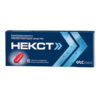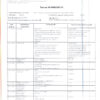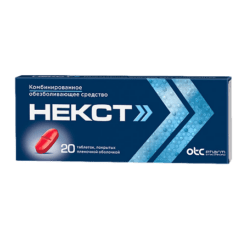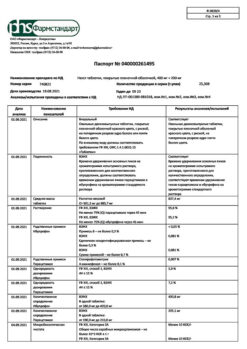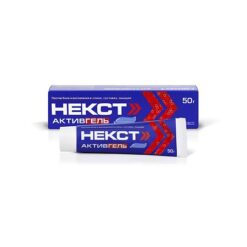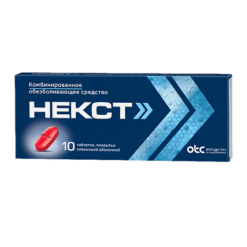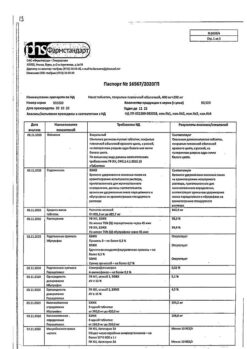No products in the cart.
Next, 400 mg+200 mg 6 pcs.
€6.57 €5.75
Description
Pharmacotherapeutic group:
an analgesic combined
(NSAID + non-narcotic analgesic)
ATX code: M01AE51
Pharmacological properties
Indications
Indications
– toothache;
– Algodysmenorrhea (painful menstruation);
– neuralgia;
– myalgia;
– back pain;
– joint pains, pain syndrome in inflammatory and degenerative diseases of the musculoskeletal system;
– pain in the joints – Pain from contusions, sprains, dislocations, fractures;
– post-traumatic and post-operative pain syndrome;
– febrile conditions (including flu and colds).
The drug is used as a symptomatic therapy for fevers, headache, muscle pain in acute respiratory diseases and influenza. The drug is intended for symptomatic therapy, reduction of pain and inflammation at the time of use, does not affect the progression of the disease.
Active ingredient
Active ingredient
Composition
Composition
Active ingredients: ibuprofen 400 mg, paracetamol 200 mg.
Auxiliary substances:
core: calcium hydrophosphate – 80.0 mg, microcrystalline cellulose – 64.5 mg, croscarmellose sodium – 24.3 mg, hyprolose (hydroxypropyl cellulose) – 19.3 mg, talc – 12.1 mg, magnesium stearate – 7.3 mg, colloidal silicon dioxide (aerosil) – 2.5 mg;
coating:
How to take, the dosage
How to take, the dosage
1 tablet 3 times a day. The maximum daily dose is 3 tablets.
The treatment duration is not more than 3 days as antipyretic and not more than 5 days as analgesic. Continued treatment with the drug is possible only after consultation with the doctor.
Interaction
Interaction
Inducers of microsomal oxidation in the liver (phenytoin, ethanol, barbiturates, flumecinol, rifampicin, phenylbutazone, tricyclic antidepressants) increase the production of hydroxylated active metabolites, which determines the possibility of severe intoxication in overdose.
Microsomal oxidation inhibitors (including cimetidine) reduce the risk of hepatotoxic effects.
Myelotoxic drugs increase the manifestation of hematotoxicity of the drug.
Cyclosporine and gold drugs increase nephrotoxicity of the drug.
The combination of ibuprofen with ethanol, glucocorticosteroids increases the risk of gastrointestinal erosive ulcers.
The concomitant use of paracetamol with ethanol increases the risk of acute pancreatitis.
Paracetamol and ibuprofen increase the effect of indirect anticoagulants and decrease the effectiveness of uricosuric drugs.
Long-term use of barbiturates reduces the effectiveness of paracetamol.
Diflunisal increases the plasma concentration of paracetamol by 50%, which increases the risk of hepatotoxicity.
Ibuprofen reduces the hypotensive activity of vasodilators, natriuretic and diuretic activity of furosemide and hydrochlorothiazide.
Antacids and colestyramine decrease absorption of ibuprofen.
Caffeine increases the analgesic effect of ibuprofen.
Ibuprofen increases the effect of oral hypoglycemic agents and insulin.
Ibuprofen increases the blood concentration of digoxin, lithium and methotrexate.
In concomitant administration with acetylsalicylic acid ibuprofen reduces its anti-inflammatory and antiaggregant effects.
Cefamandole, cefaperazone, cefotetan, valproic acid, plikamycin increase the incidence of hypoprothrombinemia.
Special Instructions
Special Instructions
The concomitant use of the drug with other drugs containing paracetamol and/or nonsteroidal anti-inflammatory drugs should be avoided.
In case of concomitant use with indirect anticoagulants, hemostasis parameters should be monitored.
Peripheral blood counts and liver function should be monitored when the drug is used for more than 5-7 days.
Paracetamol distorts the results of laboratory studies of plasma glucose and uric acid.
In case of symptoms of NSAID gastropathy (nausea, vomiting, abdominal pain, heartburn, decreased appetite, flatulence, discomfort in epigastric region) a careful control is indicated, including esophagogastroduodenoscopy, blood tests with determination of hemoglobin and hematocrit, stool analysis for hidden blood.
If it is necessary to determine 17-ketosteroids, the drug should be discontinued 48 hours before the study.
The intake of alcohol-containing beverages is not recommended during treatment.
Impact on the ability to drive vehicles, machinery
When taking the drug, patients should refrain from all activities requiring increased attention, rapid mental and motor reactions.
Contraindications
Contraindications
– gastrointestinal erosive-ulcerative diseases (acute phase), gastrointestinal bleeding;
– progressive renal disease;
– severe renal insufficiency (creatine clearance (CK) less than 30 ml/min.);
– severe hepatic insufficiency or active liver disease;
– blood clotting disorders (hemophilia, prolonged bleeding time, susceptibility to bleeding, hemorrhagic diathesis);
– Cerebrovascular or other bleeding disorders;
– The complete or incomplete combination of bronchial asthma, recurrent polyposis of the nose and sinuses, and intolerance to acetylsalicylic acid or other non-steroidal anti-inflammatory drugs, includingÑ. History
– Chronic heart failure (functional class III-IV according to NYHA classification);
After coronary artery bypass grafting;
– verified hyperkalemia;
– glucose-6-phosphate dehydrogenase deficiency;
– pregnancy (3rd trimester);
– period of breastfeeding;
– childhood under 18 years of age.
With caution
Side effects
Side effects
Side effects are listed with the frequency of occurrence according to the WHO classification: very often (with an incidence of more than 1/10), often (with an incidence of at least 1/100, but less than 1/10), infrequently (with an incidence of at least 1/1000, but less than 1/100), rarely (with an incidence of at least 1/10000, but less than 1/1000), very rarely (with an incidence of less than 1/10, including isolated reports), frequency unknown (cannot be established from the available data).
Nervous system disorders: infrequent – headache, dizziness, sleep disturbances, anxiety, hallucinations, confusion, rare – aseptic meningitis, very rare – depression.
Cardiovascular system: often – peripheral edema, very rarely – tachycardia, increased blood pressure, heart failure.
Respiratory system disorders: very rarely – shortness of breath, bronchospasm.
Gastro-intestinal tract: frequently – abdominal pain, nausea, vomiting, heartburn, decreased appetite, diarrhea, flatulence, erosive-ulcerative lesions of the gastrointestinal tract; infrequently – constipation, gum mucosal ulcers, aphthous stomatitis, pancreatitis, gastrointestinal bleeding.
Sensory organs: very rare – hearing disorders, ringing or tinnitus, visual disturbances, blurred vision or diplopia, frequency unknown – dry and irritated eyes.
The urinary system: very rare – acute renal failure, nephrotic syndrome, cystitis; frequency is unknown – polyuria.
Allergic reactions: infrequent – skin rash, pruritus, allergic rhinitis, angioedema; very rare – erythema multiforme (including Stevens-Johnson syndrome), toxic epidermal necrolysis (Lyell’s syndrome).
Hematopoietic system disorders: very rarely – anemia, thrombocytopenia, thrombocytopenic purpura, agranulocytosis, leukopenia, eosinophilia.
Skin and subcutaneous tissue: often – hyperhidrosis.
In prolonged use in high doses – hepatotoxic and nephrotoxic effects (hepatitis, interstitial nephritis and papillary necrosis); hemolytic anemia, aplastic anemia, methemoglobinemia, pancytopenia.
Overdose
Overdose
Symptoms: abdominal pain, nausea, vomiting, agitation or lethargy, drowsiness, confusion, tachycardia, arrhythmia, acute renal failure, metabolic acidosis, rapid urination, hyperthermia, headache, tremor or muscle twitching; increased hepatic transaminase activity, increased prothrombin time. If an overdose is suspected, seek medical attention immediately.
Treatment: gastric lavage followed by administration of activated charcoal, alkaline drinking, forced diuresis, symptomatic therapy, administration of donors of sulfhydryl groups (acetylcysteine) and precursors of glutathione synthesis (methionine).
Pregnancy use
Pregnancy use
When using the drug in the I and II trimester of pregnancy, caution should be exercised – use only by prescription when the potential benefit exceeds the possible risk. The use of the drug in the III trimester of pregnancy is contraindicated.
Similarities
Similarities
Additional information
| Shelf life | 2 years. |
|---|---|
| Conditions of storage | At a temperature not exceeding 25 °C. |
| Manufacturer | Pharmstandard-Leksredstva, Russia |
| Medication form | pills |
| Brand | Pharmstandard-Leksredstva |
Other forms…
Related products
Buy Next, 400 mg+200 mg 6 pcs. with delivery to USA, UK, Europe and over 120 other countries.





